Abstract
Stachybotrys atra is the etiologic agent of stachybotryotoxicosis, and this fungus and its trichothecene mycotoxins were recently implicated in an outbreak of unexplained illness in homes. S. atra was grown on sterile rice, autoclaved, dried, and then aerosolized by acoustic vibration. The distribution of particles (mass and number) was monitored on an aerodynamic particle sizer interfaced with a computer. Dust was collected on preweighed glass-fiber filters and extracted with 90% aqueous methanol. Extracts were tested for the ability to inhibit protein synthesis in rat alveolar macrophages, the ability to inhibit the proliferation of mouse thymocytes, and the presence of specific trichothecene mycotoxins. Virtually all of the particles were less than 15 micron in aerodynamic diameter, and the mass median diameter was 5 micron. Thus, most of the particles were respirable. Microscopic analysis of the generated dust revealed that ca. 85% of the dust particles were conidia of S. atra, another 6% were hyphal fragments, and the remainder of the particles were unidentifiable. Thus, greater than 90% of the particles were of fungal origin. The extracts strongly inhibited protein synthesis and thymocyte proliferation. Purified satratoxin H was also highly toxic in the same systems. Each of the individual filters contained satratoxin H (average, 9.5 ng/mg of dust). Satratoxin G and trichoverrols A and B were found in lesser amounts in some, but not all, of the filters. The limit of analysis is ca. 50 ng. These results establish that the conidia of S. atra contain trichothecene mycotoxins. In view of the potent toxicity of the trichothecenes, the inhalation of aerosols containing high concentrations of these conidia could be a potential hazard to health.
Full text
PDF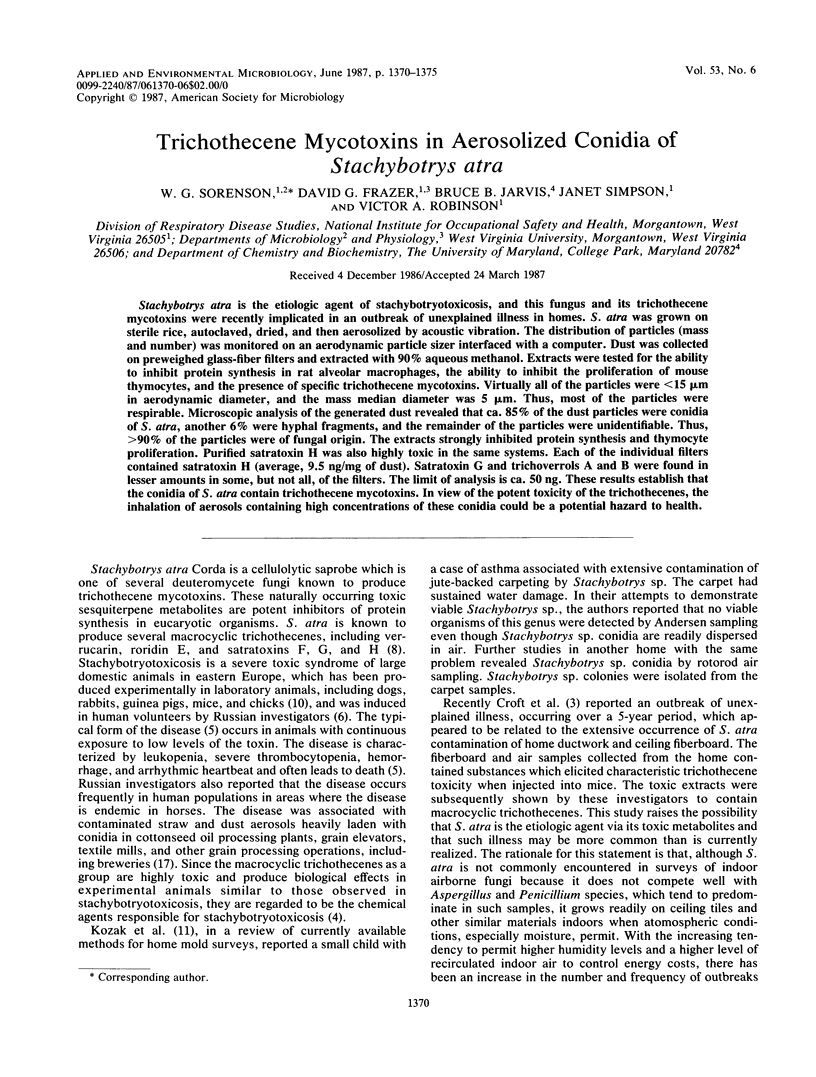

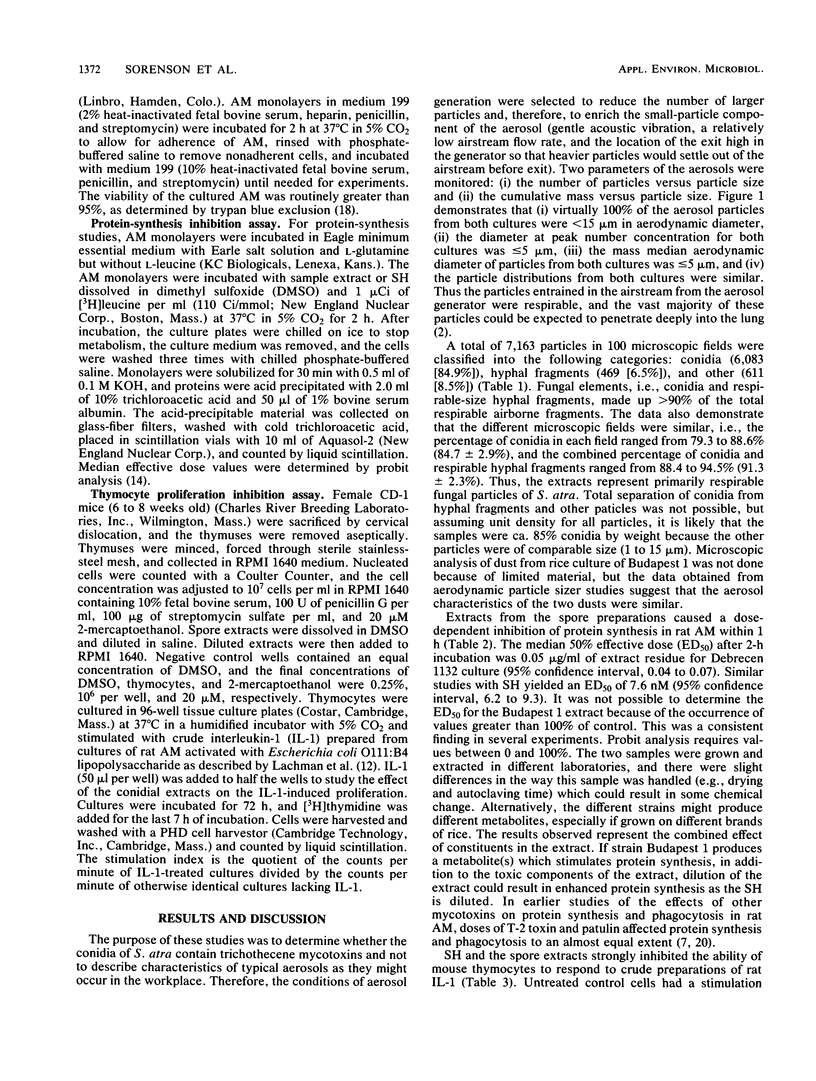
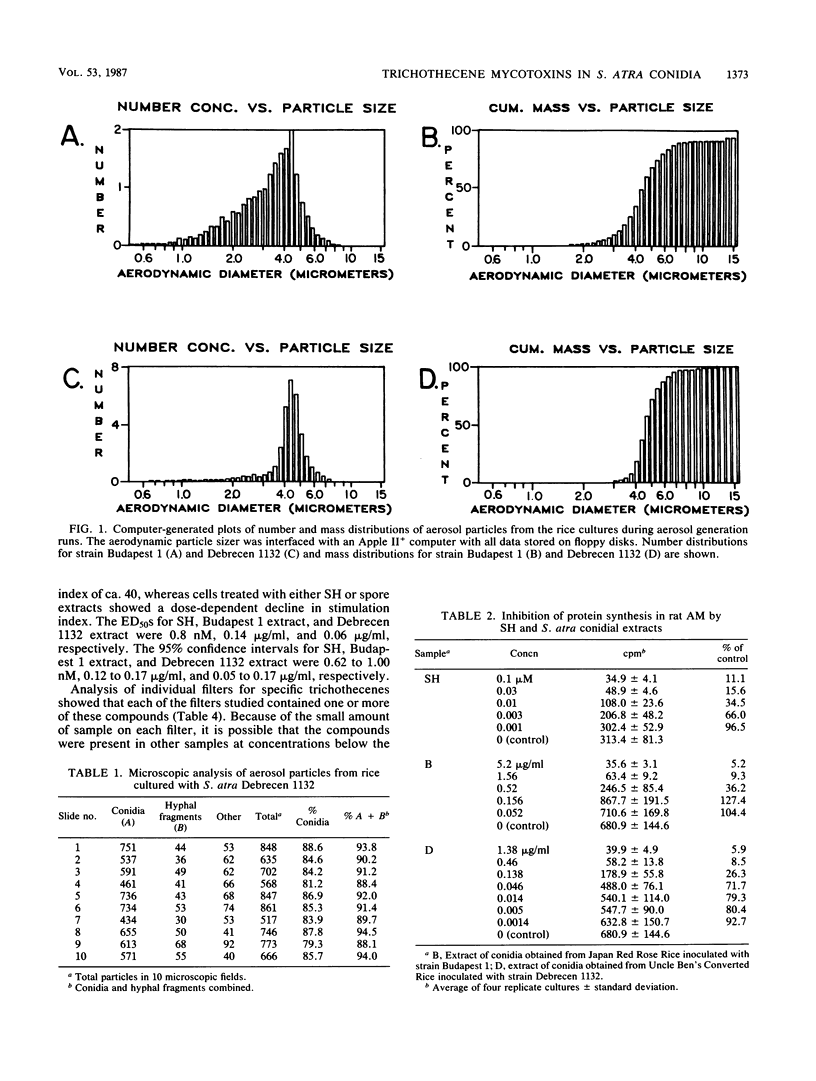
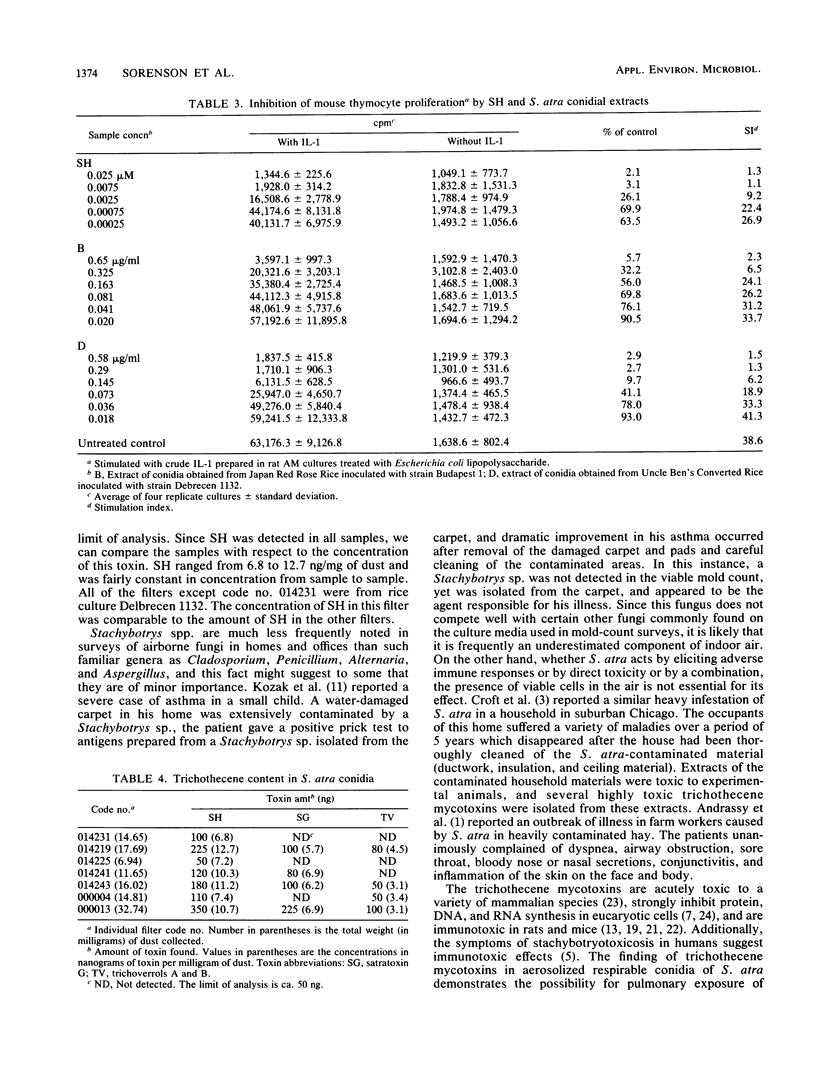
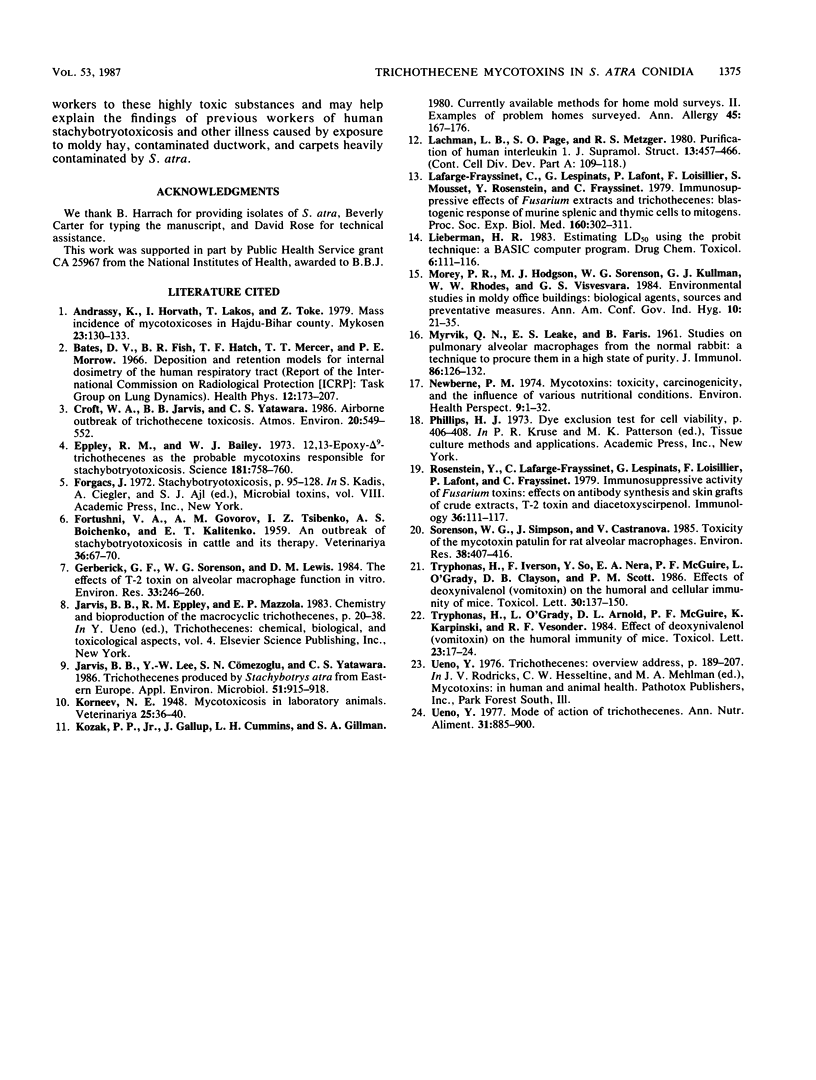
Selected References
These references are in PubMed. This may not be the complete list of references from this article.
- Andrássy K., Horváth I., Lakos T., Töke Z. Massenhaftes Auftreten von Mykotoxikosen im Komitat Hajdu-Bihar. Mykosen. 1980 Mar;23(3):130–133. [PubMed] [Google Scholar]
- Bates D. V., Fish B. R., Hatch T. F., Mercer T. T., Morrow P. E. Deposition and retention models for internal dosimetry of the human respiratory tract. Task group on lung dynamics. Health Phys. 1966 Feb;12(2):173–207. [PubMed] [Google Scholar]
- Eppley R. M., Bailey W. J. 12,13-Epoxy-delta 9-trichothecenes as the probable mycotoxins responsible for stachybotryotoxicosis. Science. 1973 Aug 24;181(4101):758–760. doi: 10.1126/science.181.4101.758. [DOI] [PubMed] [Google Scholar]
- Gerberick G. F., Sorenson W. G., Lewis D. M. The effects of T-2 toxin on alveolar macrophage function in vitro. Environ Res. 1984 Feb;33(1):246–260. doi: 10.1016/0013-9351(84)90021-5. [DOI] [PubMed] [Google Scholar]
- Jarvis B. B., Lee Y. W., Cömezoglu S. N., Yatawara C. S. Trichothecenes produced by Stachybotrys atra from Eastern Europe. Appl Environ Microbiol. 1986 May;51(5):915–918. doi: 10.1128/aem.51.5.915-918.1986. [DOI] [PMC free article] [PubMed] [Google Scholar]
- Kozak P. P., Jr, Gallup J., Cummins L. H., Gillman S. A. Currently available methods for home mold surveys. II. Examples of problem homes surveyed. Ann Allergy. 1980 Sep;45(3):167–176. [PubMed] [Google Scholar]
- Lachman L. B., Page S. O., Metzgar R. S. Purification of human interleukin 1. J Supramol Struct. 1980;13(4):457–466. doi: 10.1002/jss.400130405. [DOI] [PubMed] [Google Scholar]
- Lafarge-Frayssinet C., Lespinats G., Lafont P., Loisillier F., Mousset S., Rosenstein Y., Frayssinet C. Immunosuppressive effects of Fusarium extracts and trichothecenes: blastogenic response of murine splenic and thymic cells to mitogens. Proc Soc Exp Biol Med. 1979 Mar;160(3):302–311. doi: 10.3181/00379727-160-40439. [DOI] [PubMed] [Google Scholar]
- Lieberman H. R. Estimating LD50 using the probit technique: a BASIC computer program. Drug Chem Toxicol. 1983;6(1):111–116. doi: 10.3109/01480548309072465. [DOI] [PubMed] [Google Scholar]
- MYRVIK Q., LEAKE E. S., FARISS B. Studies on pulmonary alveolar macrophages from the normal rabbit: a technique to procure them in a high state of purity. J Immunol. 1961 Feb;86:128–132. [PubMed] [Google Scholar]
- Newberne P. M. Mycotoxins: toxicity, carcinogenicity, and the influence of various nutritional conditions. Environ Health Perspect. 1974 Dec;9:1–32. doi: 10.1289/ehp.9-1475399. [DOI] [PMC free article] [PubMed] [Google Scholar]
- Rosenstein Y., Lafarge-Frayssinet C., Lespinats G., Loisillier F., Lafont P., Frayssinet C. Immunosuppressive activity of Fusarium toxins. Effects on antibody synthesis and skin grafts of crude extracts, T2-toxin and diacetoxyscirpenol. Immunology. 1979 Jan;36(1):111–117. [PMC free article] [PubMed] [Google Scholar]
- Sorenson W. G., Simpson J., Castranova V. Toxicity of the mycotoxin patulin for rat alveolar macrophages. Environ Res. 1985 Dec;38(2):407–416. doi: 10.1016/0013-9351(85)90102-1. [DOI] [PubMed] [Google Scholar]
- Tryphonas H., Iverson F., So Y., Nera E. A., McGuire P. F., O'Grady L., Clayson D. B., Scott P. M. Effects of deoxynivalenol (vomitoxin) on the humoral and cellular immunity of mice. Toxicol Lett. 1986 Feb;30(2):137–150. doi: 10.1016/0378-4274(86)90096-2. [DOI] [PubMed] [Google Scholar]
- Tryphonas H., O'Grady L., Arnold D. L., McGuire P. F., Karpinski K., Vesonder R. F. Effect of deoxynivalenol (vomitoxin) on the humoral immunity of mice. Toxicol Lett. 1984 Oct;23(1):17–24. doi: 10.1016/0378-4274(84)90004-3. [DOI] [PubMed] [Google Scholar]
- Ueno Y. Mode of action of trichothecenes. Ann Nutr Aliment. 1977;31(4-6):885–900. doi: 10.1351/pac197749111737. [DOI] [PubMed] [Google Scholar]


